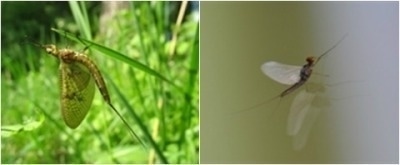Mar 1 2016
Until now, the link between rising water temperatures and higher mortality rates in aquatic animals was a bit of a chicken-and-egg situation.
 Ephemera danica (left) and Serratella ignita (right)
Ephemera danica (left) and Serratella ignita (right)
Are they dying because they're unable to absorb enough oxygen from the water? Or are they not absorbing enough oxygen because the warm water is killing them in a different way? A team of ecologists from Radboud University and Cardiff University answered this question in an article published in Global Change Biology: warm water speeds up the animals' metabolic need for oxygen to such an extent that it causes them to suffer from fatal respiratory distress.
Our earth and the water on it are warming up. This affects the growth of aquatic plants and the decomposition of organic material and this may cause respiratory distress in aquatic animals. These were the results of a recent study on the effects of water temperature and oxygen levels on the growth and survival of animals.
‘Previous studies either considered extreme temperatures in a lab setting or field studies were rather general,’ explains Wilco Verberk, an aquatic ecologist at Radboud University. Verberk’s work with the Cardiff team is the first to couple lab experiments with unique data compiled by the English Environment Agency and Natural Resources Wales that links more than 200,000 measurements to factors like water temperature, oxygen levels and the presence of aquatic insects in the field.
Verberk and his Cardiff colleagues found that the maximum temperature the animals can tolerate in a lab setting is three to five degrees lower in water with very low oxygen levels. The complementary field study found that a two-degree warming already had significant effects in water were oxygen levels were only mildly compromised.
Poor oxygenation of the watertherefore enhances the negative effects of rising water temperatures – effects that were equally as strong if not stronger in the field compared to a lab setting.
‘Warm water increases the need for oxygen in ectotherm animals,’ explains Verberk. ‘At the same time, breathing underwater is difficult because of the low solubility of oxygen, which makes it hard for aquatic animals to meet the oxygen demand. The field data shows that negative impacts already occur well below the extreme temperatures found to be lethal in the lab, probably because they are struggling to absorb enough oxygen for growth and reproduction.’
The team examined two types of mayflies that are common in northwest Europe, and occur in the Netherlands in the province of Limburg and in the clean streams of the Dutch Veluwe: the green drake (Ephemera danica) and the blue-winged olive (Serratella ignita). Water insects like these play an important role in the food chain of aquatic ecosystems. ‘I expect our results will also be relevant to other species that use gills to breathe underwater. They all face the same problem.’ See also: ‘How temperature affects growth’